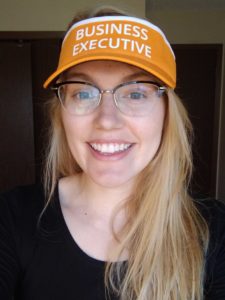
In March 2020, I co-taught my first SAFe® class. I made a big course Kanban board on the wall with each lesson and designed flip charts for feedback. I printed out the entire trainer guide (trees, RIP) and took physical notes on each page and lesson I was accountable for presenting. I printed and cut out all of the features and stories for the PI Planning simulation, divided up the pennies, and organized the room with pens and sticky notes.
I still have the “business executive” visor I like to show off to friends. Little did we know, those few days teaching that course were our last days in the office together.
In March 2021, I co-taught my first remote SAFe class. I didn’t print out or physically organize a single thing, but I did spend a lot of time preparing: I’d say three to four times as much. This time it was browser tabs, online tools, email messages, and files. And since this was my first teaching environment for any subject in a remote space, I had a lot to learn and explore.
Luckily, I wasn’t completely alone in my exploration. The SAFe® Community Platform centralized a lot of the resources and information I needed to make the class a success.
Scaled Agile-provided Preparation
Course enablement. Just as with in-person teaching, mastering the content before teaching it is vital. Listening to SAFe experts discuss the intent of each lesson and subsequently passing the exam was a great (and mandatory) first step.
Remote Trainer Badge. Taking this learning plan helped prime my mind for teaching in a remote context. It gave me confidence and allowed me to see opportunities in teaching remote rather than just its limitations. I got tips from some of SAFe’s best trainers on creative ways to teach, appropriate adjustments, and reframed expectations. For example, even with a pre-course webinar to prepare your students and yourself for the tools and technology to use in class, you should still have a plan A, plan B, and plan C, because anything can happen.
The SAFe® Virtual Classroom. With Virtual Classroom, I didn’t need to find a collaboration tool, buy a subscription, rebuild all of the activities, and have my students register for it. In one click and with no extra effort, my activities were set. Thank goodness for Virtual Classroom! I could spend my precious time elsewhere instead of tediously recreating activities and adding, copying, and pasting every user story in the PI Planning simulation.
Knowledge-check questions. At the beginning of every trainer guide, there’s a link to a set of quiz questions associated with each lesson written in the style of the certification exam. Right now, it’s still a bit tedious to transfer all of the knowledge-check questions and answers to a polling tool, but this ended up being a highlight for several of our students. It was a great review of each lesson and was a good litmus test to give confidence that the students were learning and retaining information.
Self-guided Preparation
Reviewing each slide. Getting very comfortable with the content and flow of the course is important to me. This largely means going through each slide and adding notes for stories, metaphors, and analogies—no trees harmed this time. Taking the time to get creative with the content enabled me to set up jokes and prepare realia props to surprise and delight students.
Preparing each activity. This may seem tedious and redundant, but really getting clear on the activities and exactly how they will be performed set both me and my students up for success. The virtual space can be confusing sometimes, so getting crystal clear on resources, breakout rooms, timeboxes, and objectives is key, especially when there are a few ways to run activities.
Virtual audience engagement research. This means Google searching and YouTube browsing about how to make a remote class effective and fun. I wanted to get suggestions from experts in the general business of video conferencing, from webinars to interactive courses. I learned about alternatives to slide decks, relevant icebreakers, and online tools to keep the class on track.
Was the class 100% perfect? No. But I went in feeling prepared, taking advantage of several available resources. I took risks and tried new things. And ultimately, I learned from the experience.
I discovered that remote SAFe teaching is nothing to be afraid of. For many people like me, it’s simply something new, something different, and something with which to experiment, have fun, and fail fast. In the words of one of my favorite professors, “The best teachers are the ones who try.” So, get caught trying.
About Emma Ropski

Emma is a certified SAFe 5 Program Consultant and scrum master at Scaled Agile. As a lifelong learner and teacher, she loves to illustrate, clarify, and simplify helpful concepts to keep all teammates and students of SAFe engaged.
Share:
Back to: All Blog Posts
Next: Aligning Global Teams Through Agile Program Management: A Case Study